
views
Getting Ready to Bathe Your Kitten

Recognize when your kitty needs a bath. The fact of the matter is, many cats don't need to be bathed at all, since they are masters at grooming and cleaning themselves. However, if your cat has fleas, if he's an outdoor kitty who has stepped in something vile, or if he just looks and feels dirty, then it may be time to give that kitty a bath. If your kitty is very young, then you should wipe him off with a wet or damp washcloth instead of giving him a full-on bath. Talk to your vet about when is a good time to give your little kitty a full-on bath. According to the Animal Compassion Network, you should wait until your kitty is at least 8 weeks old before giving him a full-on bath. One benefit to bathing your kitty when he's young is that this will make him used to bathing if he routinely gets dirty. Just remember that cats spend about 30% of their time grooming and that they really shouldn't be bathed more than once or twice a year unless they get really dirty.

Trim your kitten's nails. Even the most mild-mannered kittens will protest a bit when you bathe them, especially if it's for the first time. To protect yourself from getting scratched by your favorite furry creature, you should make sure to trim his nails a bit so he's less likely to hurt you when you're bathing him. Though a kitten's scratches may not be as ferocious as those of a full-grown kitty, you could still get hurt. It's better to do this to keep yourself safe, even if your kitty protests a bit. You shouldn't trim your kitten's nails right before you bathe him, however. Do it the day before or at least a few hours before. A lot of cats get a bit feisty and riled up after their nails are trimmed, and you want your little critter to be in a calm frame of mind before you begin the bath. If you haven't trimmed your kitten's nails yet, you're better off leaving quite a bit of time between nail trimming and bathing — even a full day. Nail trimming can be a new and scary experience for a young kitty, and you don't want to make it worse by adding a bath into the mix.

Brush your kitten's fur. Before you soak your little kitten, you should brush his fur, getting his coat, his legs, his belly, and even the top of his head. This is important because you'll be making sure that his fur is free of tangles and knots. If you put a kitty with uncombed fur into the bath, then you will be making those knots and tangles worse and will be creating a problem that could be avoided. Don't overlook this important step. Some kitties actually love having their fur brushed and look at this as a very relaxing process. However, others get a little panicked or agitated when their fur is brushed. If this process does not relax your cat, then give him an hour or two at least to calm down before the bath begins. Playing some soft music in the background will also relax your kitty and help draw his attention away from the pending bath. Giving your kitty a little treat after brushing him in time to the music can make the process feel more positive.
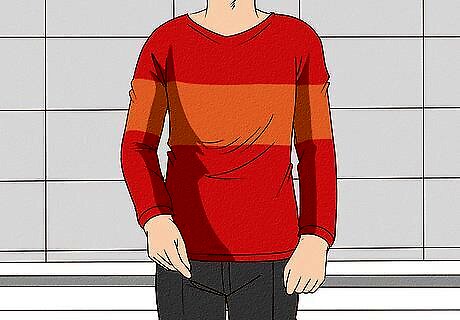
Wear protective clothing. Don't bathe your kitty in a little tank top that exposes your arms and chest. Instead, put on a long-sleeved shirt with decent thickness, so your kitty is less likely to scratch you. Some extremists say you should even protect your hands, but this is only if you know that your cat loves to bite and scratch. It's better to be safe than sorry, and wearing a long-sleeved shirt can keep you from having scratches up and down your arms. You should also try to pick a thick cotton material for your clothes so your kitty doesn't get his nails caught on your clothes. Pick something that is hard to claw through.

Have your kitty shampoo ready. Kittens need a special baby shampoo, and cats with fleas need one formulated to kill fleas, flea eggs, etc. Cats without fleas can use general cat shampoo. Go to a pet store, your veterinarian, or shop at an online retailer. If you are in doubt, ask a sales associate for information on the best shampoo. Don't just bathe your kitten with soap or with general shampoo, or you can really hurt your kitty or irritate his skin. Don't use dog shampoo if you have it on hand, either. It needs to be tailor made to suit your kitty's needs.
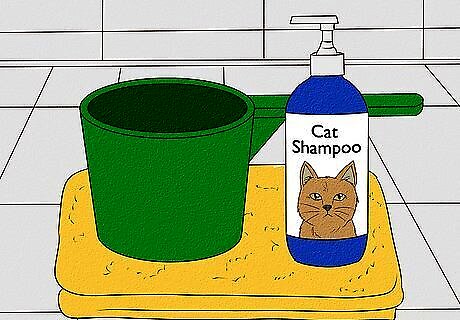
Get your kitty bathing materials ready. When you are ready to bathe the cat, get a cup for pouring water and a towel to dry the cat with. Get the shampoo ready. If you have an extra person to help you, that's great, too! Having all of your supplies ready in advance can help you bathe your kitten when the moment comes. You don't want to finally get your kitty in the bath to find that you've left the shampoo or towel in the other room. It's also a good idea to close the door of your bathroom to keep your kitty from running off.

Make the bath appealing for your kitten. If your kitten is new to baths and new to the world, you can try to make the bath a less scary place for your kitty. You can take some of his favorite toys and place them in the sink or basin you're using, or even associate the area where you're bathing him with fun and joy, so he doesn't think of it as a scary place. You can even play with him in the sink or basin without bathing him there at first, so he gets comfortable in that environment. When the time comes to bathe your kitten, you can even throw in a few of his favorite toys, or a few bath toys, to make him comfortable. You can even get him used to playing with the bath toys in a dry environment first.

Bathe your kitty when he's feeling calm. This is a very important point. Don't bathe your kitty one minute after you've played for half an hour and gotten him all riled up, or after he's gotten agitated after spotting a bug in the room. Avoid bathing him just before his usual mealtime, or he's likely to be agitated and anxious, wanting food instead of a bath. Instead, pick a time when he's usually calm, resting, or just relaxed and not in need of anything. Though he'll naturally get excited pretty fast, it's better to start off with a calm kitty so you make it easier for yourself and your little creature to get through the bath. You can also schedule a play session that tires your kitty out and then wait half an hour for him to get tired and to rest before bath time.
Bathing Your Kitten

Prepare your kitty's bath. The most common places to bathe your kitty are either in the sink or in a basin. Smaller enclosures make it easier to bathe your kitty and to maintain control of him. An entire bathtub will make it much harder to bathe your kitty. Though some people like to fill the basin and then "dip" their kitty into the water, this can actually cause your little one to panic, so you should only try this as a last resort. More commonly, you should place your kitty in the basin and then slowly pour lukewarm water over him. You can also consider putting a rubber bath mat at the bottom of the sink or basin to help keep your kitty from slipping. Some people like to fill the basin with just an inch or two of lukewarm water to get kitty's paws used to the water before the bath begins. You can even do this as a training run in preparation for later bathing, if you like. If your cat is really afraid of water, then you may have to ease the little guy into the process.
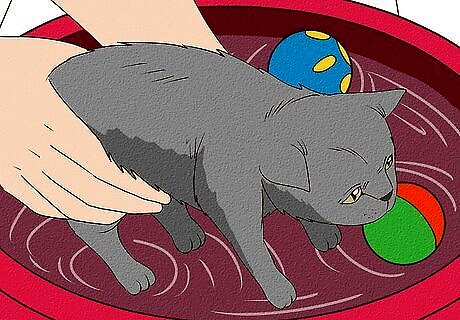
Help keep your kitty calm. The cat will most likely cling to everything in an attempt to avoid the bathtub. Just take him down gently, one paw, then the other. Put him back in the sink. You might try gently holding the front shoulder section in front of his chest downward and using the other hand to shampoo the back of the cat while you keep his lower part down. Keep the panic or worry out of your voice and your kitty is likely to feel more calm and reassured. If you start freaking out, he'll sense that you're worried and will be more likely to mimic your reactions. Pet your kitty while keeping a firm grip on his back or shoulders. If he's more calm sticking partly out of the basin with his front paws, then you can keep him in this position instead of placing his entire body in the basin.
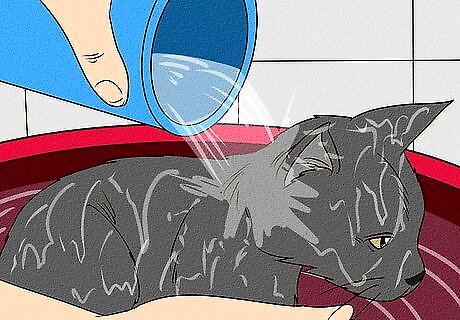
Just add water. While the cat is in the kitchen sink or basin, start using the cup to pour lukewarm water on the cat until it is completely wet. Pour it gently over your kitty, even petting and stroking his fur while you do it so he feels calm. If you have a helper, then one person can help maintain control of the kitty by holding onto his shoulders while the other person pours the water. Pour no more than half to a full cup of water over your kitty at a time, and try to avoid his face at this point. Alternatively, you can fill the sink partway and dip the kitten in the water. If you choose this approach, then you can first place your kitty into just a little bit of the lukewarm water until his paws are wet, compliment him, and then dip him in more water. If you do this, though, try to fill the basin or sink when your kitty is in the other room, because some kitties are scared by the sound of running water.
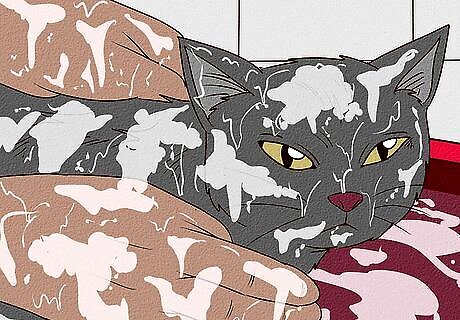
Shampoo your kitty's body. Use a small amount of shampoo, rub it together, and start on the cat's back. Work through the tail, hind legs, front legs, and neck. Be sure to get the tummy as well. If your kitty is really not liking this process, you can shampoo a little bit of kitty at a time, wash him off, and repeat. You don't want to cover your kitty with soap and then find it impossible to rinse him off before he runs off. You can use your hands or even a washcloth to help clean your kitty. You should gently massage the shampoo into your kitty's fur and body. Treat it like it's the hair of a baby and avoid stroking his fur too hard. Be kind and gentle and your kitty is more likely to relax. Your kitty may really not like the shampoo. Just keep reassuring him or her and try to keep kitty calm by staying calm yourself. Try to keep the soap out of your kitty's eyes. You don't want to hurt the little critter in the process of bathing him.

Rinse the cat off with lukewarm water. Once you've cleaned your kitty with the shampoo, you should begin to rinse him off. You can gently pour water onto your kitty from a pitcher, using your hands to wash his fur, until the water runs clear. If your kitty is in a sink, you can drain it so the soapy water disappears. Keep pouring a bit of water at a time over your kitty's body until he is shampoo free. For extra help, you can also use a wet washcloth and run it over your kitty's body. Some kitties love and are fascinated by faucets. If your cat is not scared off by faucet water and you're bathing him in a sink, you can use a gentle stream of lukewarm water to help rinse off your kitty. Make sure the water isn't hot, as the kitten could get burned.

Wash your kitty's face with water. There's no real need to wash your kitty's face with shampoo. Just a bit of water on his face will help keep him clean and fresh. You can use a wet washcloth to dab his face to make it easier. Take care not to get water in your kitty's eyes or nose and to be gentle with his face. Some kitties don't like to have their faces touched, especially when there's water involved, so you should be as gentle as possible. Whatever you do, do not place your kitty's face underwater. Doing so is guaranteed to make him panic.
Drying Your Kitten

Blot your kitten dry. At first, it can help to blot your kitty dry with a towel before you wrap him in a towel. This will help get off some of the dampness and will keep him from feeling like you're trapping him in a wet enclosure. Just gently blotting his face, body, and fur can make your kitty feel a bit more relaxed before you place him in a towel. Some people even use hair dryers on the lowest setting to help dry their kittens. You have to do what works best for your cat. Some are fascinated by the dryer and some are are terrified of it. If your kitty is okay with the hairdryer, then place it on the lowest heat setting and gently dry his fur just as you would with your hair, only taking a bit more care not to scare your kitty or harm him.

Wrap the kitten in a big fluffy towel to dry him off. Once you manage this, you should quickly dry the cat to get most of the dampness off. Be aware that small animals can lose a great deal of body temperature through damp fur so dry the kitten as much as possible, before providing a heat source for him/her to dry in front of. The towel may make the kitty feel a little claustrophobic and he may panic a little, but it's important to dry him off as much as you can. Your kitty will likely also shake the water off himself, like a dog. If you have a long-haired kitty, then you should brush his fur after the bath to get rid of any tangles that maybe have been caused by the bath.

Reward your little one for a job well done. Afterwards, offer treats, cuddles, hugs, and kisses. Your poor baby has just experienced one of the worst things it can. Most cats hate water! (However, two exceptions are the Turkish Van, and Bengal breeds.) Even if your kitty will get used to the baths, the initial experience is likely to have been a bit upsetting, and you should acknowledge that. Also, if you give your kitty treats after the bath, then he will associate baths with good things instead of bad, and he'll be more likely to want a bath in the future.




















Comments
0 comment